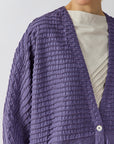





HINODE HAORI TUNIC
This one-size Haori is cut generously from a combination of cotton jersey for the torso and sleeve and lawn patterned with pintucks for the rest. Rows of stitching running horizontally across the body, which is lined with lawn, create texture in the jersey cloth. The top layer of the jersey is shorn to reveal channels of linear tactile raw edges. The cloth is cut on the bias to prevent loose threads.
In Japan, historically, a Haori was hip-length and worn over a kimono; in modern-day Japan, it's the term given to a wear-over-anything open front, loose top with few or no buttons.
Colour is applied using a garment dye process, which involves dyeing fully constructed garments. This allows for unique colour variations and a softer feel.
Finished with inseam side pockets and a single button fastening.
CODE: 1070514






